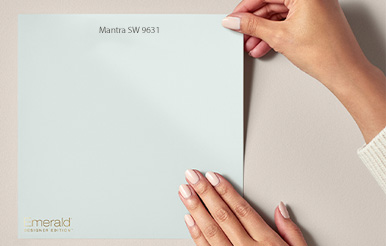Five Simple Tips to Add Color With Confidence
Watch these five simple tips to add color with confidence, professional color tips.
Video Transcription:
With paint there are so many beautiful colors to choose from.
So how do you know which color is right for you and your home?
Let's sit in with Becky Ralick Spak, senior designer with Sherwin-Williams and homeowner Meredith Brooks to learn a few tips.
A great place to begin when you're looking at color is with your existing furnishings, things such as your carpeting, flooring... areas that have already a large amount of color.
So if you can give me some ideas of where we're going to begin and what you're keeping, that will be helpful in establishing some colors that we can grow from.
Sure, with the rooms that we're going to be looking at in particular, the living room, the dining room and the office, I do have some things in there that we're going to need to work off of.
Good.
In the dining room, in the living room I have existing drapery that I would like to try to keep.
So I'd like to work around that with the wall color.
We also have existing carpeting that we're not going to be replacing.
It's a pretty neutral color but I want to keep that in mind.
And then the other thing I thought might be important is all of those rooms come off of the foyer in the kitchen and this is the hardwood floor.
That's in both of those rooms so I thought you might want to know about that as well.
That's perfect, you've really done your homework.
One thing that I'm struggling with is finding my true style.
Do you have any tips that could help me?
A great place to start would be with magazines.
You start to see a specific style, you start to see specific colors and when you find something you like, tear it out and start your own individual folder.
You start to see a pattern and it's very helpful then when you look at both furnishings and with paint selection in color.
Another idea would be to try your closet.
People don't think of that but it's a perfect place to begin.
You have colors that you like, you have items that are, very comfortable for you and you should take into consideration those items when you're selecting color.
Because they will translate very well into your home and make you feel very comfortable.
Another place, if you're still at odds would be the idea cards in the stores.
They show specific styles with colors already painted.
It gives you an idea of how things are going to look in that particular home or style and then you sort of get a better idea of how that will translate to your home.
So all those ideas will help in the color selection process.
What I've done is picked these warm tones that you currently have in your home so that we can take a look and I can give you some ideas on how to use color, especially in an open floor plan.
One idea might be to use a monochromatic color scheme using one entire strip, either using two, three, four colors, maybe even all the colors on this strip.
But what that does is create sophistication.
It's subtle and it creates harmony so there's balance going from room to room.
I really like that idea.
In fact, it seems like a nice, easy way to be safe with your colors.
The one thing I do worry about is, I don't want it to be boring.
Does monochromatic tend to get boring?
Oh certainly not, monochromatic gives you a, sort of neutral backdrop or a palette to work from.
What I mean by that is you can add accent colors, to accent walls and your furnishings.
You can bring seasonal colors in.
So contrast in colors such as greens and oranges.
You mentioned that you liked red, so we can add some interest with that.
Even if you have an architectural feature such as a niche, we can create a contrasting color in that area and really call attention and focus to that particular area.
One thing that I find frustrating is I find a color on the strip in the store that I really love, select it, get the paint, bring it home, paint out the entire room and find that it looks nothing like the color on the strip.
Do you have any tips for me?
You're not alone, we hear that quite frequently.
And yes, I do have some ideas for you.
Certainly take the strip home and look at it under your lighting.
It's so critical.
Lighting and color go hand-in-hand together.
You need to look at how that color is going to look.
With the natural sunlight coming in, natural lighting coming in, through your windows, as well as the artificial lighting.
The lighting of your lamps, the overhead ceiling lights, it's all going to change.
Not to mention your furnishings, they’re going to reflect different colors, as well, onto that color of paint.
So take it home with you.
Lighting is something I never thought about before, affecting the color.
Another thing you can do is try the color to go samples.
They are samples of paint that you could get tended to any color that you choose.
You bring them home, you apply them to your wall and you have a great experience of color that you can then look and see what it's going to look like within your space, because you have all the elements.
You have your furnishings, you have your natural lighting, you have your artificial lighting.
And then, if you don't feel like painting a wall, you can always paint a piece of poster board and with that you can take it around to different walls in your room and you can see what that color is going to look like.
Whether it's next to the window, where the sunlight is coming in, whether it's next to your book cases where it's a little dark and you might have a shadow.
Well, that sounds like a much safer plan than painting out the entire room.
Another thing that I need advice on is how to select color for an open floor plan, where do I start and stop with color?
An open floor plan isn't as difficult as it may seem.
What you need to do is just look for natural elements.
Architectural elements, such as a wall jutting out, maybe it's an arch or a doorway, and then use those as a natural break for color.
What if there is no natural break?
If there's no natural break for color?
You always remember to go back to your monochromatic system or floor plan and what you do is just carry color on a same strip.
You could go from lighter to darker, from room to room.
And it flows naturally.
Okay.
And finally, when you think about any painting project, even if you're just looking at one specific room, you really need to look at the whole house in its entirety, because eventually, it has a domino effect and you need to consider all those colors, and how they will flow from room to room.
So even if you're just working on one room for this phase, think about phases to come and how you will incorporate colors into those rooms as well.
And that way you have flow and continuity throughout your entire home.
I can't believe what a difference these colors have made in this house.
Oh I'm so happy that we've been able to help you out.
Certainly, if you think about it we started with your existing color blonde in the foyer, and we worked a monochromatic scheme but we added some accent colors too.
We went into your office with the red color family "Stolen kiss".
And then adding that blonde, carrying it from the foyer into the office.
It really looks wonderful.
Right, that little architectural feature you had, that little knock out, that bump out in the study, we did that with blonde, it was fabulous.
It really calls sort of attention to the bookcase, that's located there as well.
Definitely, before it went unnoticed.
And in the living room we carried out the monochromatic scheme, with the color ivory, which is one shade lighter than blonde, which is in your foyer.
So we're able to make it look very natural and flow very nice from your foyer into your living room.
And it's warm.
-It is warm.
-It’s very neutral but it's warm.
What do you think of the dining room?
Becky, I love, love the dining room.
The color made such a difference in here.
I was a little worried that it was going to be dark.
I was worried about going the same above and below the chair rail.
The minute they started putting the color on the walls, I just, I can't tell you how much I love this room, it's so warm.
Wonderful, I know you expressed concern early on about the monochromatic scheme being very dull and boring.
You were a little concerned about that.
So what I did was take this punch of color, and really use it to inspire conversation and make your guests feel really warm in this room.
By carrying that color above and below the chair rail, we really just keep it very sort of consistent and just comfortable.
We used the Roycroft Adobe in this dining room, from the historical preservation palette.
Because it very much suits your style and your furnishings that you have in the home already.
Then in order to sort of create a flow off the foyer, I also suggested we use this color in your powder room, which I think looks fantastic in that small space.
It really warms it up.
And we haven't even talked about the tray ceiling and how great that looks in this room.
I'm glad you're pleased, so many people forget about the ceiling especially a tray ceiling that has these architectural details to it that you can embellish.
And what we did was carry through from your foyer in your living room the colors blonde and ivory and apply those.
And then just do a soft color wash of the illusions gold metallic.
Just to give a little subtle hint of glimmer and some visual image and some interest for your guests.
Your tip on utilizing all these colors and accessories from room to room, it just really helped pull this house together.
It's always important, the sort of the finishing touch, really the icing on the cake that really pulls everything together.
Not only that but it identifies your personality.
And it should always represent your personality and your likes and interests, not mine or someone else's, because it's a reflection of your home and the occupants in this home.
So it's very important.
Another interesting element that we did was that niche at the top of the stairs, sort of just washed away.
And what we did was pull that red color family “Stolen kiss” from your office and highlight that area.
Then just have the painter do a light color washing over it, so it really becomes a shadow box if you will, a really highlight to your guests as they enter your home and look up.
Becky, I can't thank you enough for the help that you've given me.
With the tips that I learned through the process I feel that I can really select color with confidence.
And you know what, I had so much fun doing it.
I'm pleased that you're happy with the results and that you had fun doing it as well.
Keep these simple color tips in mind and color selection is easy.
Whether you're choosing color for a single room or a whole house, keep these simple tips in mind.
Decide what features are going to stay and make color choices that work with them.
Use magazines, friends' homes, even your favorite clothes to help identify styles and colors that suit you.
Bring color home.
Paint sample areas or poster boards to see how light affects color in your rooms.
Pull it all together with accessories that carry your palette from one room to another.
Selecting color isn't a science, it's an expression of who you are and the life you live.
Ask Sherwin-Williams.









